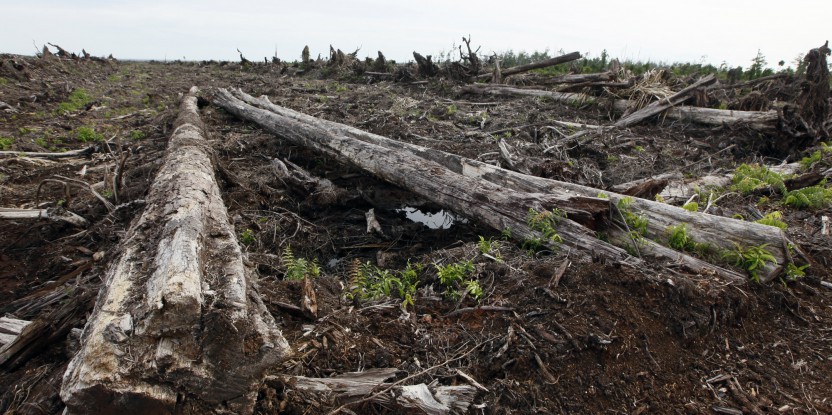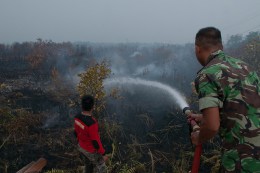
BOGOR, Indonesia—Scientists monitoring the amount of carbon accumulated in Indonesia’s peatland forests over thousands of years have predicted that millions of tons of carbon dioxide could be released into the atmosphere if they continue to be cleared, drained and burned for oil palm and agricultural plantations.
“Indonesia’s peat swaps have evolved over thousands of years to create the perfect storage systems to lock away carbon dioxide that contributes to climate change,” said Sofyan Kurnianto, a scientist with the Center for International Forestry Research (CIFOR) and the lead author of a new study.
“But it is only now that we are beginning to understand the magnitude of emissions released when peatlands are cleared and burned for agriculture or oil palm.”
While scientists have long understood the carbon storing potential of tropical peatland forests—they lock up to five times more carbon than tropical forests and account for a third of the world’s total carbon reserves—much less is known about the actual amounts of carbon stored in their soils and the impacts of unsustainable land-use practices.
More than 100,000 hectares of peatland forests are destroyed each year for oil palm and agricultural plantations. When peat swamps are drained, converted, and burned, large quantities of stored carbon are released into the atmosphere.
PUTTING A NUMBER ON IT
A 2010 report suggests that 85 percent of Indonesia’s greenhouse gas emissions stem from land-use activities, with 37 percent due to deforestation and 27 percent due to peat fires.
The new CIFOR study is the first to use the Holocene peat model to bring together existing data on vegetation types, litter decomposition rates and water table depths found in Indonesia’s coastal and inland peatland areas to estimate the amount of carbon accumulated over 11,000-year and 5,000-year periods.
The model was then used to create a number of scenarios to predict the future impacts of forest clearing and peat burning for oil palm conversion.
It found that of the 3,300 tons of carbon per hectare stored in Indonesia’s coastal peatland areas, up to half would be released into the atmosphere over the 100 years following conversion to oil palm plantations—the equivalent of 2,800 years worth of accumulated carbon.
“What was surprising was just how slow the process of carbon accumulation and the development of peatland soils actually is, but when we disturb these systems through human activity, carbon dioxide is released very quickly,” said Daniel Murdiyarso, Principal Scientist at CIFOR and co-author of the report.
Put another way, in one year more than 2,300 hectares of pristine coastal peatland forests—the equivalent of 3,200 soccer fields—would be needed to absorb the same amount of carbon lost over 100 years from just one hectare of converted forest.
Scientist hope to develop the model to estimate methane emissions and carbon matter lost in drainage runoff, which could increase the carbon loss estimates by up to 20 percent.
CARBON ACCOUNTING FOR REDD+
The study highlights the need for global efforts to reduce emissions from deforestation and forest degradation (as in the initiative known as REDD+) to take into account carbon emissions lost through changing land-use practices and the challenges of reforesting and restoring degraded tropical peatlands.
“Tropical peatland ecosystems are very acidic and have fewer nutrients than boreal peatlands, so if the pH balance is disrupted, they are very difficult to restore,” Kurnianto said.
“It could take thousands of years to regain the carbon lost from conversion.”
The Indonesian government recently approved an agreement to reduce haze pollution from peatland fires. It comes after the number of fires started in the province of Riau, Sumatra, reached a record high in 2013. However, the new legislation will need to be robust if Indonesia is to meet its global commitment to reduce greenhouse gas emissions by 26 percent by 2020.
Previous CIFOR research found that in 2012, forest fires in Riau province released between 1.5 billion and 2 billion tons of carbon emission in just one week—up to 10 percent of Indonesia’s total annual emissions.
“Preventing the loss of emissions through peatland preservation and better land management practices is much better than cure,” Kurnianto said.
“Hopefully this research will contribute to a growing awareness within the government and local communities of the importance of peatland conservation for the global climate system.”
For more information about this research, please contact Daniel Murdiyarso at d.murdiyarso@cgiar.org.
This research forms part of the CGIAR Research Program on Forests, Trees and Agroforestry.
We want you to share Forests News content, which is licensed under Creative Commons Attribution-NonCommercial-ShareAlike 4.0 International (CC BY-NC-SA 4.0). This means you are free to redistribute our material for non-commercial purposes. All we ask is that you give Forests News appropriate credit and link to the original Forests News content, indicate if changes were made, and distribute your contributions under the same Creative Commons license. You must notify Forests News if you repost, reprint or reuse our materials by contacting forestsnews@cifor-icraf.org.
